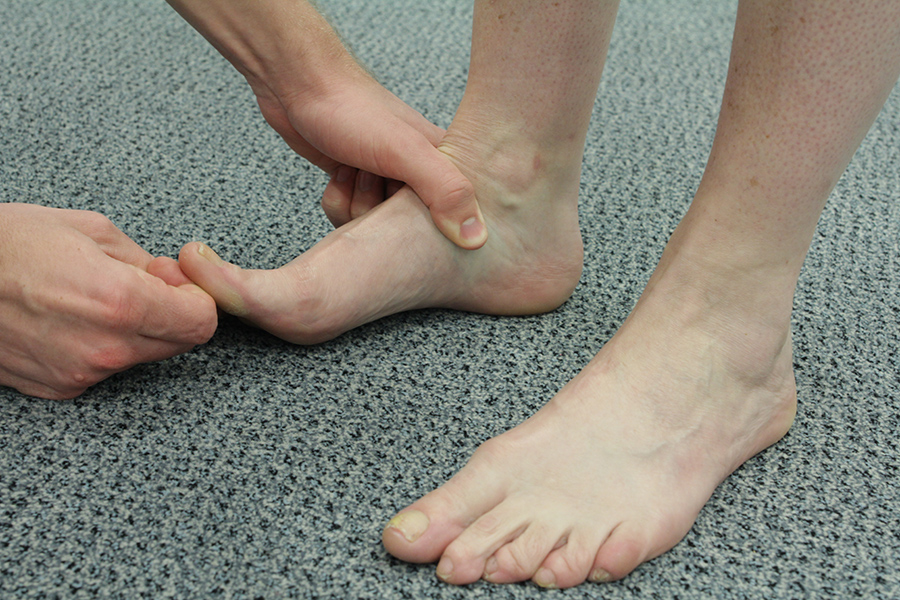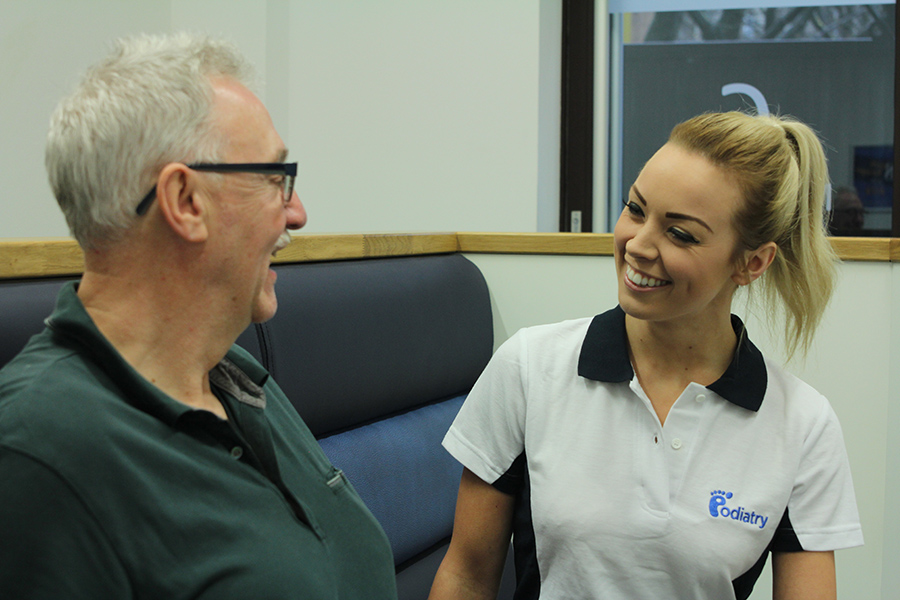Bunions
The word bunion describes a deformity of either the big toe joint or the little toe joint. The deformity causes there to be a bony bump at the side of the toe joint and this can cause pain. A bunion doesn't always cause pain, however for many people a bunion can be unsightly. Bunions can also make finding accommodative footwear problematic.
A bunion is a very common foot deformity that can affect either the big toe joint or the little toe joint. The correct term for a bunion of the big toe joint is hallux abducto valgus, whereas a bunion that affects the little toe joint is known as a Tailors bunion or 'bunionette'.
A bunion is actually the head of the metatarsal, which has moved out of position and has angled itself outwards. Sometimes extra bone can form at the head of the metatarsal caused by friction from footwear. Friction against bone causes the bone to become damaged, when a bone is damaged it responds by creating more bone, which creates an even larger lump. When this happens the extra bone is called an exostosis.
The pain associated with bunions is caused by irritation to the bursa (bursitis). A bursa is a fluid filled sac that overlies bony lumps in order to protect them. Irritation of the bursa caused by the friction of footwear can lead to inflammation, and the result is pain, swelling and redness.

There are many causes that can lead to the development of bunion formation, they include:
Neuromuscular and connective tissue disorders that can lead to hallux abducto valgus include:
The signs and symptoms of a bunion may include:
There are two types of bunion, they are:
Tailors bunion (bunionette)
A Tailors bunion is a bunion that appears at the joint of the little toe, at the point where the fifth metatarsal meets the toe. The bony lump is the head of the fifth metatarsal, which has moved out of its position.
Hallux abducto valgus (commonly known as a bunion)
Hallux abducto valgus describes a bunion formation at the big toe joint. Hallux means big toe, abducto means that it drifts towards the second toe, and valgus refers to the position. Hallux abducto valgus is the most common type of bunion.
If you have a bunion Chiropody.co.uk can help you. Bunions are progressive bone deformities, this means that they get worse over-time. It is important, therefore, to seek treatment early in bunion development in order to get the greatest benefit from treatment.
The following benefits may be achieved following podiatric assessment and treatment for bunions:
Podiatry for a bunion would first involve an assessment which would include:
Other treatment options might include one or more of the following:

Bunions are bony projections (lumps) that appear at either the big toe joint or the little toe joint. The bony lump is the head of the metatarsal, however over time extra bone can grow, creating an even larger lump (an exostosis). Bunions can be painful; this is because they can rub against footwear leading to inflammation.
If you have a bunion that is causing you problems visit one of our podiatrists who will be able to help. Our podiatrists will devise a treatment plan specific to you, the aim of which will be to reduce any pain and inflammation associated with the bunion, as well as information and advice on what you can do to prevent the bunion from getting any worse.
To arrange an assessment with one our podiatrists please email office@chiropody.co.uk or call 0330 088 4222
What are bunions?
A bunion is a very common foot deformity that can affect either the big toe joint or the little toe joint. The correct term for a bunion of the big toe joint is hallux abducto valgus, whereas a bunion that affects the little toe joint is known as a Tailors bunion or 'bunionette'.
A bunion is actually the head of the metatarsal, which has moved out of position and has angled itself outwards. Sometimes extra bone can form at the head of the metatarsal caused by friction from footwear. Friction against bone causes the bone to become damaged, when a bone is damaged it responds by creating more bone, which creates an even larger lump. When this happens the extra bone is called an exostosis.
The pain associated with bunions is caused by irritation to the bursa (bursitis). A bursa is a fluid filled sac that overlies bony lumps in order to protect them. Irritation of the bursa caused by the friction of footwear can lead to inflammation, and the result is pain, swelling and redness.

What causes bunions?
There are many causes that can lead to the development of bunion formation, they include:
- Poor biomechanics
- Arhridities (e.g. gout, osteoarthritis, rheumatoid arthritis)
- Increased curvature of the fifth metatarsal
- An enlarged fifth metatarsal head (in the case of a Tailors bunion)
- Broad feet
- Genetics: bunions often run in families
- Poorly fitting footwear
- Foot type (e.g. flat feet)
- They are more common in women (this is because women typically have looser ligaments compared to that of men)
Neuromuscular and connective tissue disorders that can lead to hallux abducto valgus include:
- Cerebral palsy
- Multiple sclerosis
- Downs syndrome
- Marfans syndrome
- Ligamentous laxity
What are the signs and symptoms of a bunion?
The signs and symptoms of a bunion may include:
- A painful and tender bump at the side of either the big toe joint or the little toe joint (however a bunion doesn't always cause pain)
- Redness
- Swelling
- Bursitis (inflammation of the bursa)
- Neuritis (irritation of a nerve)
Types of bunion
There are two types of bunion, they are:
Tailors bunion (bunionette)
A Tailors bunion is a bunion that appears at the joint of the little toe, at the point where the fifth metatarsal meets the toe. The bony lump is the head of the fifth metatarsal, which has moved out of its position.
Hallux abducto valgus (commonly known as a bunion)
Hallux abducto valgus describes a bunion formation at the big toe joint. Hallux means big toe, abducto means that it drifts towards the second toe, and valgus refers to the position. Hallux abducto valgus is the most common type of bunion.
Benefits of podiatry for bunions
If you have a bunion Chiropody.co.uk can help you. Bunions are progressive bone deformities, this means that they get worse over-time. It is important, therefore, to seek treatment early in bunion development in order to get the greatest benefit from treatment.
The following benefits may be achieved following podiatric assessment and treatment for bunions:
- Decrease in pain
- Decrease in inflammation
- Improvement in foot function
- Improvement in comfort
- Prevention of deterioration of symptoms
- Appropriate referral (if necessary)
What would podiatry for bunions involve?
Podiatry for a bunion would first involve an assessment which would include:
- A medical history
- A history of the problem
- Signs and symptoms
- An examination
Other treatment options might include one or more of the following:
- Anti-inflammatory advice
- Orthoses
- Advice and education
- Joint mobilisation
- Padding
- Footwear advice
- Surgery

Summary
Bunions are bony projections (lumps) that appear at either the big toe joint or the little toe joint. The bony lump is the head of the metatarsal, however over time extra bone can grow, creating an even larger lump (an exostosis). Bunions can be painful; this is because they can rub against footwear leading to inflammation.
If you have a bunion that is causing you problems visit one of our podiatrists who will be able to help. Our podiatrists will devise a treatment plan specific to you, the aim of which will be to reduce any pain and inflammation associated with the bunion, as well as information and advice on what you can do to prevent the bunion from getting any worse.
To arrange an assessment with one our podiatrists please email office@chiropody.co.uk or call 0330 088 4222
Save 5% by booking an appointment online.

Find your nearest clinic
We have clinics located throughout the North West. We also provide a home visit service.
Find out more »

No waiting lists!
Tired of waiting for treatment? Be seen by a podiatrist today!
Find out more »

Not sure how we can help?
Speak to a podiatrist to find out how we can help. Call us on 0330 088 4222.
Find out more »
We work with:

Individuals

Organisations

Health professionals
Get in Touch!
0330 088 4222
If you would like to speak to one of our specialists then please complete this form.
We are open 7 days a week








